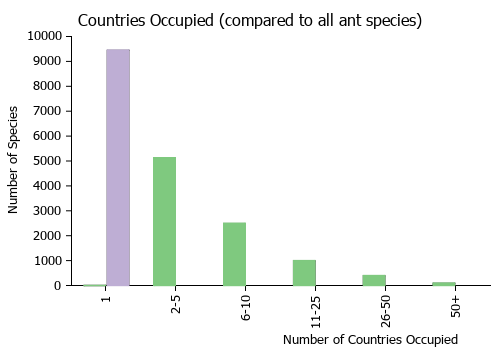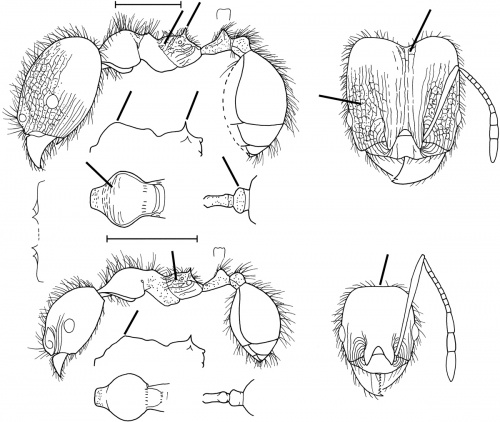Pheidole industa
| Pheidole industa | |
|---|---|

| |
| Scientific classification | |
| Kingdom: | Animalia |
| Phylum: | Arthropoda |
| Class: | Insecta |
| Order: | Hymenoptera |
| Family: | Formicidae |
| Subfamily: | Myrmicinae |
| Tribe: | Attini |
| Genus: | Pheidole |
| Species: | P. industa |
| Binomial name | |
| Pheidole industa Santschi, 1939 | |
Nothing is known about the biology of industa.
Identification
See the description in the nomenclature section.
Keys including this Species
Distribution
Only known from the type locality.
Latitudinal Distribution Pattern
Latitudinal Range: -34.833° to -34.833°.
| North Temperate |
North Subtropical |
Tropical | South Subtropical |
South Temperate |
- Source: AntMaps
Distribution based on Regional Taxon Lists
Neotropical Region: Uruguay (type locality).
Distribution based on AntMaps
Distribution based on AntWeb specimens
Check data from AntWeb
Countries Occupied
| Number of countries occupied by this species based on AntWiki Regional Taxon Lists. In general, fewer countries occupied indicates a narrower range, while more countries indicates a more widespread species. |

|
Estimated Abundance
| Relative abundance based on number of AntMaps records per species (this species within the purple bar). Fewer records (to the left) indicates a less abundant/encountered species while more records (to the right) indicates more abundant/encountered species. |

|
Biology
Castes
Worker
Minor
Images from AntWeb
   
| |
| Paralectotype of Pheidole industa. Worker. Specimen code casent0913429. Photographer Z. Lieberman, uploaded by California Academy of Sciences. | Owned by NHMB, Basel, Switzerland. |
Nomenclature
The following information is derived from Barry Bolton's Online Catalogue of the Ants of the World.
- industa. Pheidole rufipilis st. industa Santschi, 1939e: 316, fig. 3 (s.w.) URUGUAY. Raised to species: Wilson, 2003: 305.
Unless otherwise noted the text for the remainder of this section is reported from the publication that includes the original description.
Description
From Wilson (2003): A member of the fallax group similar in various characters to Pheidole chiapasana, Pheidole dentata, Pheidole humeridens, Pheidole laeviventris, Pheidole madrensis, Pheidole maja and Pheidole tetroides, differing as follows.
Major: rugoreticulum on sides of head covering most of genae and extending posteriorly to halfway between eyes and occipital border; carinulae originating on frontal lobes extend all the way to occiput, where they become a small patch of rugoreticulum; antennal scapes reach posteriorly well beyond midpoint from eye to occipital corner; sides of propodeum rugulose-carinulate; profile of pronotum in dorsal-oblique view elevated well above that of mesonotal convexity, and smoothly convex; propodeal spines long and vertical to basal propodeal face; postpetiole from above elliptical.
Minor: sides of propodeum rugulose-carinulate; humerus subangulate in side view; occiput in full-face view flat.
MEASUREMENTS (mm) Lectotype major: HW 1.60, HL 1.60, SL 1.08, EL 0.24, PW 0.80. Paralectotype minor: HW 0.80, HL 0.86, SL 1.04, EL 0.20, PW 0.48.
COLOR Major: concolorous light reddish (almost yellowish) brown.
Minor: concolorous medium brown.
Figure. Upper: lectotype, major. Lower: paralectotype, minor. Scale bars = 1 mm.
Type Material
URUGUAY: Montevideo. Naturhistorisches Museum, Basel - as reported in Wilson (2003)
Etymology
Unknown, possibly L industria, busy, active. (Wilson 2003)
References
- Santschi, F. 1939e. Études et descriptions de fourmis néotropiques. Rev. Entomol. (Rio J.) 10: 312-330 (page 316, fig. 3 soldier, worker described)
- Wilson, E. O. 2003. Pheidole in the New World: A dominant, hyperdiverse ant genus. Harvard University Press, Cambridge, MA. (page 305, fig. major, minor described, Raised to species: new status)
References based on Global Ant Biodiversity Informatics
- Santschi F. 1939. Études et descriptions de fourmis néotropiques. Revista de Entomologia (Rio de Janeiro). 10: 312-330.
- Zolessi L. C. de, Y. P. Abenante, and M. E. de Philippi. 1988. Lista sistematica de las especies de Formicidos del Uruguay. Comun. Zool. Mus. Hist. Nat. Montev. 11: 1-9.
- de Zolessi, L.C., Y.P. de Abenante and M.E. Philippi. 1987. Lista sistemática de las especies de formícidos del Uruguay. Comunicaciones Zoologicas del Museo de Historia Natural de Montevideo 11(165):1-9



